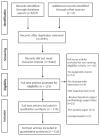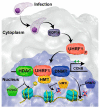A Systematic Review of Apicomplexa Looking into Epigenetic Pathways and the Opportunity for Novel Therapies
- PMID: 36839571
- PMCID: PMC9963874
- DOI: 10.3390/pathogens12020299
A Systematic Review of Apicomplexa Looking into Epigenetic Pathways and the Opportunity for Novel Therapies
Abstract
Interest in host epigenetic changes during apicomplexan infections increased in the last decade, mainly due to the emergence of new therapies directed to these alterations. This review aims to carry out a bibliometric analysis of the publications related to host epigenetic changes during apicomplexan infections and to summarize the main studied pathways in this context, pointing out those that represent putative drug targets. We used four databases for the article search. After screening, 116 studies were included. The bibliometric analysis revealed that the USA and China had the highest number of relevant publications. The evaluation of the selected studies revealed that Toxoplasma gondii was considered in most of the studies, non-coding RNA was the most frequently reported epigenetic event, and host defense was the most explored pathway. These findings were reinforced by an analysis of the co-occurrence of keywords. Even though we present putative targets for repurposing epidrugs and ncRNA-based drugs in apicomplexan infections, we understand that more detailed knowledge of the hosts' epigenetic pathways is still needed before establishing a definitive drug target.
Keywords: Cryptosporidium parvum; DNA methylation; Toxoplasma gondii; epidrugs; histone modification; malaria; miRNA; non-coding RNA; parasite infection; protist.
Conflict of interest statement
The authors declare no conflict of interest.
Figures






Similar articles
-
Toxoplasma gondii and Cryptosporidium parvum lack detectable DNA cytosine methylation.Eukaryot Cell. 2008 Mar;7(3):537-40. doi: 10.1128/EC.00448-07. Epub 2008 Jan 4. Eukaryot Cell. 2008. PMID: 18178772 Free PMC article.
-
The clever strategies used by intracellular parasites to hijack host gene expression.Semin Immunopathol. 2020 Apr;42(2):215-226. doi: 10.1007/s00281-020-00779-z. Epub 2020 Jan 30. Semin Immunopathol. 2020. PMID: 32002610 Review.
-
Putative SET-domain methyltransferases in Cryptosporidium parvum and histone methylation during infection.Virulence. 2022 Dec;13(1):1632-1650. doi: 10.1080/21505594.2022.2123363. Virulence. 2022. PMID: 36097362 Free PMC article.
-
The plant-type ferredoxin-NADP+ reductase/ferredoxin redox system as a possible drug target against apicomplexan human parasites.Curr Pharm Des. 2005;11(24):3159-72. doi: 10.2174/1381612054864957. Curr Pharm Des. 2005. PMID: 16178751 Review.
-
DNA topoisomerases in apicomplexan parasites: promising targets for drug discovery.Proc Biol Sci. 2010 Jun 22;277(1689):1777-87. doi: 10.1098/rspb.2009.2176. Epub 2010 Mar 3. Proc Biol Sci. 2010. PMID: 20200034 Free PMC article. Review.
References
-
- Waddington C.H. The Epigenotype. Endeavour. 1942;1:18–20. doi: 10.1093/ije/dyr184. - DOI
Publication types
Grants and funding
LinkOut - more resources
Full Text Sources

